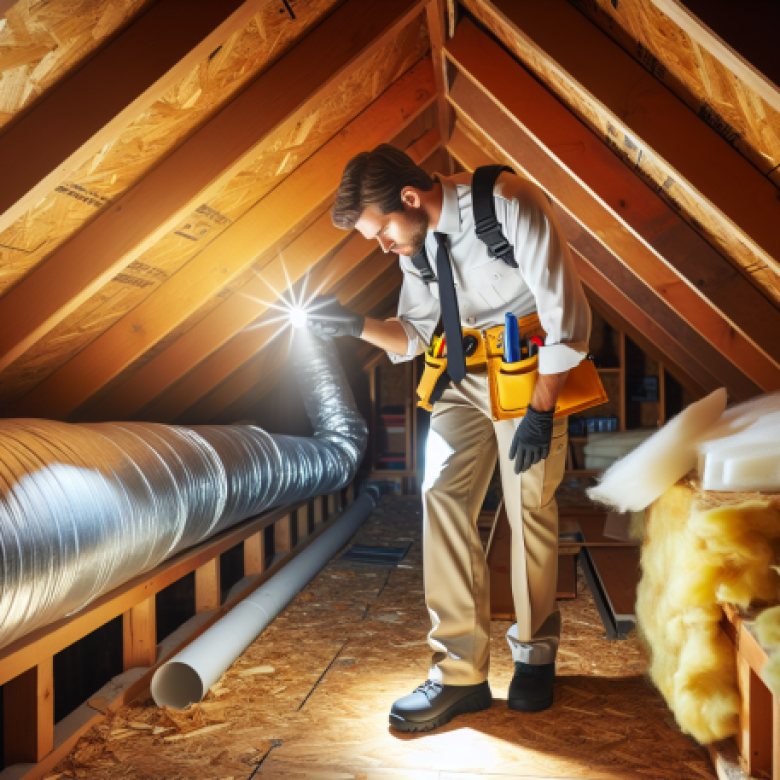Have you ever wondered about the impact of indoor air quality on your health? As experts in property restoration, including mold assessment and remediation, Projekt Restoration understands the importance of clean, healthy air in our homes and workplaces. We’ve seen firsthand how poor indoor air quality can lead to health issues, and we’re here to shed light on this often overlooked aspect of our daily lives.
Indoor air quality can significantly affect our health, productivity, and overall quality of life. Pollutants such as mold, dust, and chemicals can cause a range of health issues, from minor irritations like allergies and asthma to serious conditions like chronic obstructive pulmonary disease (COPD) and lung cancer. At Projekt Restoration, we believe in creating healthier indoor environments by addressing these issues head-on, providing solutions that not only restore properties but also improve the air we breathe.
But how exactly does indoor air quality impact our health? And what can we do to ensure the air in our homes and workplaces is clean and safe? Join us as we delve into these questions, drawing on our years of experience and the latest research in the field. We’ll provide practical tips and insights, helping you to better understand and improve the air quality in your own environment. So, are you ready to breathe easier? Let’s explore the impact of indoor air quality on health together.
Understanding Indoor Air Quality
Indoor air quality (IAQ) refers to the air quality within and around buildings and structures, particularly as it relates to the health and comfort of building occupants. It’s influenced by a variety of factors, including but not limited to, the presence of mold, dust, chemicals, and other pollutants. For a comprehensive understanding of your IAQ, consider a mold assessment or infrared thermal imaging.
Contrasting indoor and outdoor air quality, the former is often more polluted due to the concentration of pollutants in a confined space. Outdoor air, while also subject to pollution, is generally better due to the open environment and natural air circulation. However, both indoor and outdoor air quality can significantly impact health.
To ensure optimal IAQ, regular dehumidification and content cleaning are recommended. These measures can help to reduce the presence of pollutants, thereby improving the overall indoor air quality.
Common Indoor Air Pollutants and Their Sources
Indoor air pollutants, a silent threat to health, are often overlooked. Dust, a common household nuisance, is more than just an eyesore. It’s a carrier of allergens and bacteria, compromising the indoor air quality. Similarly, mold, a frequent unwelcome guest in damp areas, releases spores that can trigger allergies or even serious health issues.
Radon, a naturally occurring radioactive gas, can infiltrate homes through cracks in the foundation, posing a significant health risk. Carbon monoxide, an odorless and colorless gas, is a byproduct of burning fuels. It’s often linked to faulty heating systems and can cause severe health problems if not detected.
Volatile Organic Compounds (VOCs), emitted from a wide range of products like cleaning supplies and building materials, can cause headaches, dizziness, and long-term health effects.
HVAC systems, if not properly maintained, can circulate these pollutants throughout the home. Regular mold assessment and dehumidification can help control mold and dust. Ensuring proper ventilation and using reconstruction materials with low VOCs can significantly improve indoor air quality.
The Impact of Indoor Air Quality on Physical Health
Poor indoor air quality is a silent assailant, often leading to a myriad of health complications. It’s a significant contributor to allergies, asthma, and various respiratory diseases. A study by the Environmental Protection Agency (EPA) reveals that indoor air pollutants are 2-5 times higher than outdoor levels. This alarming statistic underscores the importance of maintaining good indoor air quality.
Exposure to these pollutants can trigger allergic reactions, including sneezing, coughing, and eye irritation. More severe impacts include the development of asthma, a chronic condition affecting millions worldwide. The World Health Organization (WHO) also links poor indoor air quality to respiratory diseases such as pneumonia and chronic obstructive pulmonary disease (COPD).
Moreover, long-term exposure to poor indoor air quality can lead to life-threatening conditions like lung cancer. The American Lung Association warns that radon, a common indoor air pollutant, is the second leading cause of lung cancer. Therefore, it’s crucial to ensure your indoor air quality is not compromised. Reach out to professionals for help in assessing and improving your indoor air quality.
The Impact of Indoor Air Quality on Mental Health
Poor indoor air quality can significantly impact mental health, often leading to stress, anxiety, and depression. Studies have shown that exposure to pollutants, such as mold and dust, can trigger neurological responses that exacerbate mental health conditions. For instance, the mold removal process can significantly improve indoor air quality, thereby reducing the risk of mental health issues.
Moreover, the World Health Organization (WHO) has reported a strong correlation between poor indoor air quality and mental health disorders. The consulting services at Projekt Restoration can provide expert advice on improving indoor air quality, which can subsequently enhance mental well-being.
Furthermore, the use of advanced infrared thermal imaging can detect hidden issues affecting indoor air quality. By addressing these problems, individuals can create a healthier living environment, reducing stress and anxiety levels. Therefore, maintaining good indoor air quality is not just crucial for physical health, but also for mental health.
The Long-Term Effects of Poor Indoor Air Quality
Continuous exposure to poor indoor air quality can lead to significant long-term health effects. The potential for chronic diseases and conditions is alarmingly high. For instance, respiratory ailments such as asthma and bronchitis can be exacerbated or even initiated by poor indoor air quality.
Moreover, the risk of developing serious conditions like lung cancer and heart disease increases with prolonged exposure to polluted indoor air. It’s crucial to understand that these health risks are not just confined to individuals with pre-existing conditions. Even healthy individuals can fall prey to these chronic diseases due to continuous exposure to poor indoor air quality.
To mitigate these risks, it’s essential to ensure that your indoor air quality is up to standard. At Projekt Restoration, we provide comprehensive solutions to improve your indoor air quality. Our mold assessment services can identify potential sources of indoor air pollution, while our dehumidification solutions can help maintain optimal humidity levels, reducing the risk of mold and mildew growth.
Remember, your health is your wealth. Don’t let poor indoor air quality rob you of it.
How to Improve Indoor Air Quality
Enhancing indoor air quality is a crucial step towards a healthier living environment. One effective method is regular cleaning, which eliminates dust and allergens, reducing the risk of respiratory issues. For a thorough cleaning, consider content cleaning services.
Proper ventilation is another vital aspect. It facilitates the circulation of fresh air and expulsion of pollutants. If you’re dealing with humidity issues, dehumidification can help maintain an optimal indoor climate, preventing mold growth.
Air purifiers are also beneficial, filtering out harmful particles and improving air quality. If you’re concerned about potential mold issues, mold assessment can provide peace of mind.
Remember, each of these strategies contributes to a healthier indoor environment, reducing the risk of health issues and enhancing overall well-being.
The Role of Government and Regulatory Bodies in Indoor Air Quality
Government and regulatory bodies play a pivotal role in maintaining indoor air quality. They establish and enforce standards that protect public health and the environment. For instance, the Clean Air Act in the United States sets forth regulations to control air pollution, including indoor air quality. These laws are enforced by agencies such as the Environmental Protection Agency (EPA).
Moreover, these bodies also provide resources and guidelines to help individuals and businesses improve indoor air quality. For example, the EPA offers a comprehensive guide on mold assessment and remediation, a common indoor air quality issue.
In addition, they conduct research and development to advance our understanding of indoor air quality and develop more effective solutions. For instance, the EPA’s Indoor Environments Division conducts research on indoor air pollutants, their sources, and health effects.
Lastly, these bodies also provide consulting services to help businesses comply with indoor air quality regulations and improve their practices. This not only ensures compliance but also promotes a healthier indoor environment.
In conclusion, government and regulatory bodies play a crucial role in maintaining indoor air quality through regulation, research, and support services.
Case Studies on Indoor Air Quality and Health
In one instance, a family in Cooper City experienced severe health issues due to poor indoor air quality. The culprit was mold growth, triggered by water damage. Persistent coughs, allergies, and fatigue plagued the family until they sought help from professionals. After a thorough mold assessment, the source of the problem was identified and resolved through comprehensive mold removal and dehumidification.
Another case involved a business in Davie. Employees reported frequent headaches and respiratory problems. An infrared thermal imaging inspection revealed hidden moisture issues leading to poor air quality. The business took immediate action, implementing a complete mold removal and dehumidification process.
These cases underline the importance of regular indoor air quality checks and prompt action when issues arise. Ignoring such problems can lead to serious health implications. The lessons learned? Regular inspections, immediate action, and professional help are key to maintaining healthy indoor air quality.
The Future of Indoor Air Quality
Emerging trends in indoor air quality are revolutionizing our approach to health and wellness. The advent of smart homes and air quality sensors is a game-changer. These advancements allow us to monitor and control our indoor environment like never before. For instance, smart homes equipped with air quality sensors can detect pollutants and allergens, alerting homeowners to potential health risks.
Moreover, these technological advancements could have a profound impact on our health in the future. By providing real-time data on indoor air quality, they empower us to make informed decisions about our living conditions. This could lead to a significant reduction in health issues related to poor air quality, such as allergies and respiratory problems.
In the future, we might see more homes equipped with these technologies, making them a standard feature in home reconstruction and design. As we continue to understand the importance of indoor air quality, it’s clear that these advancements will play a crucial role in promoting healthier living spaces.
For more information on improving your indoor air quality, visit our contact page to get in touch with our team of experts.
Frequently Asked Questions About Indoor Air Quality and Health
- "What are the health risks associated with poor indoor air quality?" Poor indoor air quality can lead to a variety of health issues, including allergies, respiratory problems, and even heart disease. For more information, visit our mold assessment page.
- "How can I improve the air quality in my home?" Regular cleaning, proper ventilation, and use of air purifiers can significantly improve indoor air quality. Check out our dehumidification services for more tips.
- "Can indoor plants improve air quality?" Yes, certain indoor plants can help filter out harmful toxins and improve air quality. However, they should be used in conjunction with other air quality improvement measures.
- "How does humidity affect indoor air quality?" High humidity levels can encourage the growth of mold and mildew, negatively impacting indoor air quality. Our sunrise restorations service can help manage humidity levels in your home.
- "What are the signs of poor indoor air quality?" Common signs include persistent allergies, frequent respiratory infections, and a constant musty odor. If you notice these signs, consider our Fort Lauderdale mold removal service.
Remember, maintaining good indoor air quality is crucial for your health. If you have any concerns, don’t hesitate to contact us.





